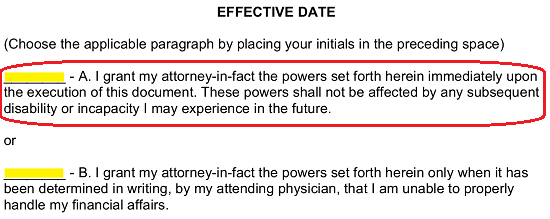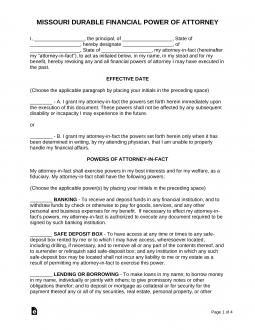Updated August 11, 2023
A Missouri durable power of attorney form is a document that a principal can use to appoint another person to take care of his or her financial affairs. Upon the form being signed with a notary public, the person selected to handle the affairs, the “agent”, will be able to make banking, real estate, and other kinds of business transactions on behalf of the principal. The form only terminates if canceled or upon the death of the principal.
Table of Contents |
Laws
Title XXVI, Sections 404.700 to 404.735 (Durable Power of Attorney Law of Missouri)
Definition of Durable
“Durable power of attorney”, a written power of attorney in which the authority of the attorney in fact does not terminate in the event the principal becomes disabled or incapacitated or in the event of later uncertainty as to whether the principal is dead or alive and which complies with subsection 1 of Section 404.705 or is durable under the laws of any of the following places:
(a) The law of the place where executed;
(b) The law of the place of the residence of the principal when executed; or
(c) The law of a place designated in the written power of attorney if that place has a reasonable relationship to the purpose of the instrument (§ 404.703(4))
Definition of “Power of Attorney”
“Power of attorney”, a written power of attorney, either durable or not durable (§ 404.703(4)); “Attorney in fact”, an individual or corporation appointed to act as agent of a principal in a written power of attorney (§ 404.703(1)).
Signing Requirements
The principal and the agent are required to have their signatures acknowledged by a notary public (§ 404.705(3)).
How to Write
1 – The Missouri Delegation Paperwork Should Be Obtained On This Page
The form enabling you to formally document a Principal’s assignment of Principal Authority to an Agent may be opened and/or downloaded by clicking the “PDF,” “Word,” or “ODT” buttons on this page.
2 – Identify The Individuals Involved With This Appointment In The Introduction
The first paragraph shall contain six blank lines. We will need to use these spaces to identify the Principal (Grantor of Power), the Attorney-in-Fact (Agent assuming Principal Power), and each one’s Physical address.
Use the first three blank spaces to record the Principal’s Full Name, Legal Residential Street Address, and the State where he or she lives. Please note, when recording the Principal’s Address make sure to enter the Building Number, Street Name, (if relevant) Unit Number, and County (or City) where he or she maintains a residence.  Then, utilize the next three blank lines to document the Full Name of the Attorney-in-Fact, his or her Address of Residence, and the State where his or her Residential Address is located (respectively).
Then, utilize the next three blank lines to document the Full Name of the Attorney-in-Fact, his or her Address of Residence, and the State where his or her Residential Address is located (respectively).
3 – Determine When The Attorney-in-Fact Will Be Able To Wield Principal Power
The Principal will need to decide when the Authority (described in this form) becomes active. That is, when will the Attorney-in-Fact be expected and able to use Principal Authority on behalf of the Principal.
If the Principal has determined the Agent should have access to Principal Power at the time of the Principal Signing and approves this delegation to remain in effect even if disabled or incapacitated, then he or she should initial the first statement (Choice A). The Principal may wish to delay the delegation of Principal Authority to the Agent until he or she is disabled or incapacitated. If so, he or she should initial the second statement (Choice B).
The Principal may wish to delay the delegation of Principal Authority to the Agent until he or she is disabled or incapacitated. If so, he or she should initial the second statement (Choice B).
4 – Define The Subjects That Are Included In The Attorney-in-Fact’s Principal Powers
The next several items, under the heading “Powers of Attorney-in-Fact,” shall consist of labeled paragraphs. Each item will describe the actions and decisions an Attorney-in-Fact may have Principal Approval to engage in. This Principal Approval will be in the Principal Act of initialing the blank space preceding a paragraph. Each initialed item shall be applied to the Attorney-in-Fact’s Principal Authority and each item left blank will be excluded from the Attorney-in-Fact’s Principal Authority. It should be noted that once the Principal signs this form, this section may not be altered.
The “Banking” paragraph contains the language to grant the Attorney-in-Fact with the Principal Power to conduct any of the activities documented within it. The Principal should initial the blank line preceding the bold label “Banking” to apply these statements to Attorney-in-Fact’s abilities.  The next item, labeled “Safe Deposit Box,” shall deliver the Principal Authority necessary for the Agent to access (and exert Principal Control over) the Principal’s Safe Deposit Boxes. To appoint the Agent with this Principal Power, the Principal will need to initial the blank line associated with this item.
The next item, labeled “Safe Deposit Box,” shall deliver the Principal Authority necessary for the Agent to access (and exert Principal Control over) the Principal’s Safe Deposit Boxes. To appoint the Agent with this Principal Power, the Principal will need to initial the blank line associated with this item.  The Principal will indicate approval for the Agent to engage in the “Borrowing And Lending” activities described in the third item by initialing the blank line corresponding to this paragraph.
The Principal will indicate approval for the Agent to engage in the “Borrowing And Lending” activities described in the third item by initialing the blank line corresponding to this paragraph.  The Attorney-in-Fact’s Principal Powers will apply to the Principal’s “Government Benefits” if the Principal initials the “Government Benefits” paragraph item.
The Attorney-in-Fact’s Principal Powers will apply to the Principal’s “Government Benefits” if the Principal initials the “Government Benefits” paragraph item.  The Principal will need to initial the blank space preceding the “Retirement Plan” paragraph to approve the Agent’s Principal Authority when dealing with a Retirement Plan on behalf of the Principal.
The Principal will need to initial the blank space preceding the “Retirement Plan” paragraph to approve the Agent’s Principal Authority when dealing with a Retirement Plan on behalf of the Principal.  The next paragraph item, “Taxes,” will delegate the Principal Authority to represent the Principal in Tax Matters. The Agent will be able to conduct any of the activities defined in this paragraph as if he or she were the Principal if it is initialed.
The next paragraph item, “Taxes,” will delegate the Principal Authority to represent the Principal in Tax Matters. The Agent will be able to conduct any of the activities defined in this paragraph as if he or she were the Principal if it is initialed.  The Agent’s Principal Powers will include the ability to represent the Principal in terms of “Insurance,” if the Principal initials the seventh paragraph.
The Agent’s Principal Powers will include the ability to represent the Principal in terms of “Insurance,” if the Principal initials the seventh paragraph.  The Principal will grant Principal “Real Estate” Powers to the Agent by initialing the eighth paragraph.
The Principal will grant Principal “Real Estate” Powers to the Agent by initialing the eighth paragraph.  The ninth paragraph, “Personal Property,” empowers the Agent with the ability to act as the Principal with the Principal’s “Personal Property.” The Principal should initial this item if he or she wishes the Agent to have Principal Approval to use such Powers.
The ninth paragraph, “Personal Property,” empowers the Agent with the ability to act as the Principal with the Principal’s “Personal Property.” The Principal should initial this item if he or she wishes the Agent to have Principal Approval to use such Powers.
The Agent will be approved of using Principal Authority to manage the Principal’s Property once the Principal initials the “Power To Manage” paragraph Principal Power regarding “Gifts” and the act of gifting will be granted to the Agent with the Principal act of initialing the tenth paragraph.
Principal Power regarding “Gifts” and the act of gifting will be granted to the Agent with the Principal act of initialing the tenth paragraph.  The ability to represent the Principal in terms of receiving in and engaging in “Legal Advice And Proceedings will be delegated to the Agent when the Principal initials the twelfth paragraph item.
The ability to represent the Principal in terms of receiving in and engaging in “Legal Advice And Proceedings will be delegated to the Agent when the Principal initials the twelfth paragraph item.  The last item may also be set to apply to the Agent’s Principal Powers. This item, however, will require direct input. If the Principal wishes to include any provisions that should apply to the Principal Authority delegated to the Agent, they should be documented on the blank lines below the paragraph labeled “Special Instructions.”
The last item may also be set to apply to the Agent’s Principal Powers. This item, however, will require direct input. If the Principal wishes to include any provisions that should apply to the Principal Authority delegated to the Agent, they should be documented on the blank lines below the paragraph labeled “Special Instructions.”
5 – The Principal and a Notary Public Must Execute This Document
Review this form thoroughly once it has been filled out. Several parties will need to be coordinated with so this form may be executed: The Principal and a Notary Public, and the Agent.
First, the Principal must fill in the Date of Signing. This can be done in the last statement (beginning with the words “In Witness Whereof.” The Principal should enter the current Calendar Day (two digits) on the first blank space in this section. The current Month will need to be supplied on the second blank space. Finally, the current Year (two-digits) must be filled into the third blank line.![]()
The blank line directly below the Signature Date statement must be signed by the Principal before a Notary Public. 
The next section is strictly for the Notary Public who is overseeing the Principal Signing. He or She will authenticate the Location, Attending Parties, and Date. He or she will also provide the required credentials and Notarization Seal.
 The “Specimen Signature And Acceptance Of Appointment” page requires the direct attention of the Agent or Attorney-in-Fact. The Agent will need to print his or her name between the words “I” and “The Attorney-in-Fact Named Above…” then sign his or her Name on the “Attorney-in-Fact’s Signature” line. This will verify his or her intent to act in the capacities listed in this document when necessary.
The “Specimen Signature And Acceptance Of Appointment” page requires the direct attention of the Agent or Attorney-in-Fact. The Agent will need to print his or her name between the words “I” and “The Attorney-in-Fact Named Above…” then sign his or her Name on the “Attorney-in-Fact’s Signature” line. This will verify his or her intent to act in the capacities listed in this document when necessary.  There will be an additional Notarization area below the Attorney-in-Fact’s signature line so that his or her act of signing can be Notarized as well.
There will be an additional Notarization area below the Attorney-in-Fact’s signature line so that his or her act of signing can be Notarized as well.

Related Forms
Download: PDF
Download: PDF, MS Word, OpenDocument




